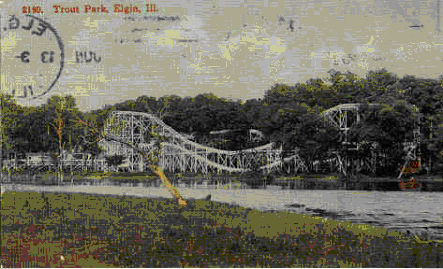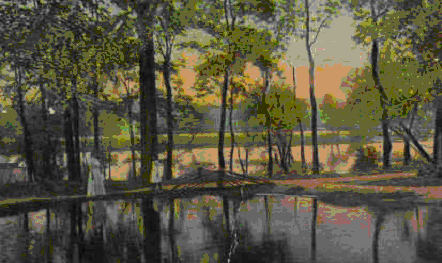Trout Park History

Dr. P.W. Pratt began a fish hatchery and enclosed a 70 acre park known then as "Cedar Swamp" by the locals. It was situated on the east side of the river, 1½ miles north of the city. The many springs in this "Trout Park" fed the ponds where young salmonade were raised. Some of the springs were believed to have medicinal values. Elk and deer were also stocked in the park, which became a popular resort for pleasure seekers, "especially Germans from Chicago." Dr. W.A. Pratt continued to improve the facility after his father's death in 1872.
On May 29, 1909, an amusement park opened at Trout Park. The highlight of attractions was the Circle Dip Roller Coaster, which was the first one of its kind. The popularity of the park waned by the end of the season, and the owners were left with a pile of bills and a bevy of judgments against them. However, while the park was operational, it treated its public to such delights as The Carousel, the Ocean Wave and the Circle Swing.
Trout Park certainly has roots planted in America's distant past. However, the Elginites of the late 19th and early 20th century had plans of their own for this lovely old park during their time. The park was home for Elgin's first professional baseball team, The Kittens, named after their manager, Malachi Kittredge. A stadium was erected for the Kittens' home games that would seat 3500 spectators.
For years, local baseball fans had supported amateur and semipro teams, but it wasn't until 1910 that the city received a professional franchise in the newly formed Northern Association. Elgin's opponents in the Class C league were Clinton, Muscatine, Jacksonville, Joliet, Decatur, Freeport and Kankakee. The Elgin Baseball Association sold two hundred fifty shares in the local club at ten dollars each and raised additional money selling booster buttons. The trolley line, interested in the fares to and from the games, made a donation and contributed the stands for new playing field at Trout Park. Elgin had an experienced manager, Malachi "Kitty" Kittredge, a former Chicago Cub catcher. So respected was Kittredge that the team adopted the nickname Kittens.
The Kittens' pitching and speed were a winning combination. Cy Boothby hurled a no-hitter early in the season, and in the home opener with the Clinton Tigers, little Fritz Maisel stole four bases. The Kittens were leading the pack with a record of 35 wins and only 19 losses when the Northern Association folded early in July. Elgin was awarded the pennant, but the chief beneficiaries of the doomed venture were the railroads. The Northern Association covered more territory than the Class B Three-Eye League, which was based in larger cities. Traveling expenses and poor attendance forced withdrawal of the weaker teams. Maisel was the only Kitten to reach the majors. Playing with New York in the American League in 1914, he set a major league record by stealing 74 bases.

In 1969, Hazel Belle Perry wrote about Trout Park in her newspaper article, "Old Elgin Tales." She wrote, "Usually, our Old Elgin Tales go back no farther than 134 years, but today's Elgin Tale takes us back thousands of years to the Glacial Period". Trout Park truly has its history during the period when the earth had gone cold and glaciers pushed down from the north and covered much of the earth with ice. As these glaciers slid south, they carried with them soil, vegetation and plants not necessarily indigenous to the area. It is theorized that white cedar trees occupied much of Northern Illinois, but were crowded out by trees more indigenous to the climate. However, since Trout Park has so many cold springs, the white cedar trees found a home here. While Trout Park became legendary for its unique and valuable vegetation, it also served as a sanctuary for birds and wildlife. Many of the birds and animals that found their homes in Trout Park were quickly becoming extinct in other portions of Northern Illinois.
In 1922, the city of Elgin took over Trout Park by an order from Mayor Arwin Price. The land was purchased from the estate of William P. Carpenter for $4,500. The original deal was for 18 acres. Two years later, Elgin would add another 35 acres from W. H. Crichton for $10,000.
Over the years, various conservation groups, including the Elgin Wild Flower Society, the Elgin Conservation Council, and The Audubon Society would use this area as a place for study and exploration.
Trout Park Nature Preserve
Trout Park Nature Preserve is a magical place. Numerous fountains water spring forth, converging into tumbling streams that fall to the river. Ravines and bluffs weave in and around the springs and wet meadows. Moisture loving trees cast their shade over a lush carpet of diverse wild flowers. This cool, moist environment gives rise to vegetation that is usually only seen in a more northerly climate. Sheltered within the hillsides and nurtured by the rich spring water, a unique habitat exits, unlike any other in the state. Uncommon species of plants and invertebrates that could not survive on the open prairie find a sanctuary here. This rare natural community is termed a forested fen.
Forested Fen
A fen is a special type of wetland. The water in a fen has a high pH level, unlike the acidity of a bog. Water seeps from the hillsides in Trout Park after flowing underground, passing through glacial deposits of limestone. This has caused the water to pick up many minerals, such as calcium carbonate, and become alkaline. Certain plants have adapted to this special growing condition. Northern White Cedar or Arborvitae, a slow-growing evergreen tree, flourishes in the calcium rich, moisture laden soil. Characteristic of forested fens and highly vulnerable to prairie fires, Arborvitae has a refuge in Trout Park.
An interesting feature of the highly calcareous streams appears when the water evaporates. Deposits of calcium carbonate form and are called tufa or marl. Recognized as crumbly, whitish rock, tufa can be found throughout the preserve.
History
Since the turn of the century people have been drawn to the beauty of Trout Park Botanists, horticulturists, scientists and students of nature have been intrigued by the unusual and diverse plant life. In the early 1920s the botanical richness of the area was recognized by local citizens when the City of Elgin began purchasing the land. For many years, the area was known as the Elgin Botanical Gardens.
In 1957, approximately a quarter of the park was condemned in order for the Northwest Tollway (Interstate 90) to be built. This condemnation was opposed by many state and national conservation groups and local residents. Although no accurate botanical records are available, tollway construction reportedly destroyed part of the richest ravine and seep community. In 1972 Trout Park was awarded some protection when it was dedicated as an Illinois Nature Preserve. It has been recognized by the state as having unique and irreplaceable natural features that must be secured against development.
Restoration
As a natural area within an urban setting, Trout Park Nature Preserve receives heavy public use. This usage, coupled with a lack of awareness of the rarity and fragility of the site by many visitors, presents a major threat to the entire ecosystem. The steep hills in the preserve are easily eroded. Loss of vegetation due to trampling and removal heightens the problem. Siltation from erosion clogs the streams and leads to the loss of aquatic life. Plant species from Europe and Asia have invaded the streams and woodlands, choking out native vegetation.
Since 1982, a committed group of volunteers has been striving to restore and maintain the integrity of the preserve. Working under the guidance of the Illinois Nature Preserves Commission and the Nature Conservancy of Illinois, the Friends of Trout Park volunteer their time in monitoring species, collecting and dispersing seeds of native wildflowers, grasses, and trees, removing invasive vegetation, maintaining trails, and leading wildflower walks. Their efforts are aimed toward ensuring that this unique natural area will be enjoyed and appreciated by future generations.
Caution
Poison Ivy is present throughout the preserve, especially along wet areas. Stay on the trails and do not touch any plant that you cannot identify.
Baseball Supports the Preserve
The baseball program supports the restoration and the preservation of the Trout Park Nature Preserve. The preserve provides a beautiful natural green backdrop to the baseball park. The volunteers of the baseball program work with those of the nature preserve to keep the area clean and safe. This joint effort insures that the park and the trail provide a wonderful experience for its visitors.
Trout Park Nature Preserve trail guides are available at the baseball park concession stand. These guides detail the trail and provide a description of the wildlife, trees and foliage in the preserve.
